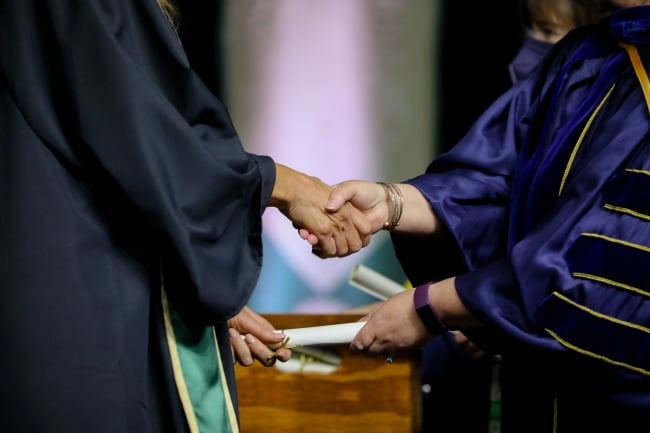You have /5 articles left.
Sign up for a free account or log in.

The Second Start program offers students a chance to reset their GPA and complete a degree at select California State University institutions.
California State University
Across the country, 38.6 million Americans have started their postsecondary journey and left before earning a credential. In California, around six million residents between ages 25 and 64 have college credit but no degree.
Recently published research from the American Council on Education found one in three college students had dropped out of college to at least some extent. Among students who stopped taking classes for more than one term, 40 percent said their poor academic performance was one of the reasons they stopped out. Over a quarter of low-income students (with total household income of less than $40,000) said not doing as well academically as expected was an essential reason they stopped taking college classes, and a similar number of students of color said this, too.
Grade forgiveness or GPA resets can support stopped-out learners who want to re-enroll and complete their degrees.
This year, the California University State system will pilot an intervention, the Second Start program, encouraging students who left college years ago due to unsatisfactory academic progress to return to their university and earn a degree.
“We’re looking to create high-quality education opportunities and educate the citizenry of California, and for those students that have left feeling like they can never go back to college again, this is a second chance, a second start, a redemption,” says Brent Foster, assistant vice chancellor and state university dean of academic programs at the CSU chancellor’s office.
The background: Around a year and a half ago, the CSU convened a meeting of provosts, vice presidents of student affairs and the chancellor’s office to investigate innovative ideas around student success. The system’s current policy on academic renewal was one sticking point for many university provosts, explains Foster, who serves as the program lead.
“There was just very little flexibility,” Foster says. “It requires a returning student that had left in poor academic standing … to jump through hoops. The thresholds they have to meet are so high, it makes it very difficult for them to return, which leaves that student leaving college thinking, ‘I’m never going back.’”
Among students who stopped out of the CSU since 2016, 130,000 left with poor academic standing, many due to extenuating circumstances that are not representative of their academic capabilities.
To identify strategies to re-enroll and support graduation of these students, officials created the Second Start pilot to collect data and establish best practices that will guide systemwide policy.
Fourteen of the CSU’s 23 campuses (big and small, throughout the state) opted in to the five-year pilot program, receiving $10,000 from the system to be used however they see fit, including building supports, conducting outreach or funding student scholarships.
How it works: Officials at each of the participating colleges will conduct outreach to students who are eligible to participate in the program to encourage them to re-enroll at the CSU. Each institution has its own committee to tailor the pilot for individual campus populations, Foster says.
To qualify, students must have left the institution at least three years ago and hold a cumulative GPA lower than 2.0. Upon re-enrollment at the institution that they initially left, students will pursue an undergraduate degree program and complete 12 units, earning a 2.5 GPA or better within 12 months.
After learners meet the 12-unit and 2.5-GPA threshold, they’re officially considered a Second Start student and will have their previous GPA wiped. Their prior grades will still be reflected on their transcript, but their cumulative GPA will reset to only include the most recent credits, Foster explains.
“That’s the part that allows them to, as I call it, [be] a redemption program,” Foster says. “They get to redeem themselves.”
CSU leaders worked with faculty members in the Academic Senate to determine eligibility and requirements for students. “That was super important—we didn’t want to overwrite or overlord something as important as GPA without getting faculty buy-in,” Foster says.
While students are enrolled, colleges will provide wraparound supports, which may include housing, basic needs support and forgiveness for small debts (such as library fines or parking tickets).
“There is this desire, not to just hold these students’ hands but at that first re-engagement to make sure that they feel comfortable to re-plant themselves in higher education,” Foster says. For students who stopped out years ago, their lives are different and higher education looks different, “so if you come back to college after an experience like that, you really need a lot more than someone just saying, ‘Well, you’ve been to college before, so take it away.’”
A critical resource will be one-on-one advising to ensure credits apply to a student’s degree program. The CSU also offers credit for prior learning, which may benefit students who have been working or gained experiences outside the classroom during their absence.
Some campuses are considering a faculty mentorship program, drawing on the lived experiences of professors who fell below academic standards and ultimately achieved success during their own education to encourage learners in their academic journeys.
What’s next: In the first year, CSU leaders expect around 400 or 500 students to re-enroll with the goal of entering the Second Start program.
This pilot is not an opt-in process open to any former CSU student who wants to restart their college education, Foster clarifies, but an intentional outreach to gauge what could work in the future. The challenge will be reconnecting with students who have spent years away from their college and helping get them back in the classroom.
Administrators are also ironing out behind-the-scenes details such as making it possible to refresh students’ GPA with the registrar’s office and how to scale those initiatives.
The CSU’s ultimate metric of success is graduation, so each campus will flag learners as they progress toward their degree to collect data on barriers they encounter. One of the challenges of the pilot will be tracking learners, because students who re-enroll will have different credit loads and they won’t move toward degrees in a cohort model but will be more spread out over terms.
Foster hopes the pilot is cut short—that within a few years system leaders have the positive results needed to make changes to policy, opening up opportunities for more students across the state.
“I know that there are going to be these examples where students come back, and they go, ‘Without this program, I would have never returned to college,’” Foster says. “‘Now I’ve returned to college … but I’ve been a huge success and now I want grad school and so on and so forth.’ I’m looking forward to those moments.”
Does your institution encourage professors to share their own stories of struggling academically but ultimately achieving success? Tell us about it.








